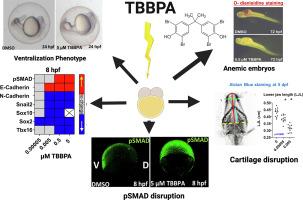Low-level tetrabromobisphenol A (TBBPA) exposure disrupts early embryonic architecture: molecular impacts on dorsoventral patterning
IF 4.3
3区 环境科学与生态学
Q2 BIOCHEMISTRY & MOLECULAR BIOLOGY
Comparative Biochemistry and Physiology C-toxicology & Pharmacology
Pub Date : 2025-09-06
DOI:10.1016/j.cbpc.2025.110348
引用次数: 0
Abstract
Tetrabromobisphenol A (TBBPA), a widely used flame retardant in textiles and electronics, poses toxicological risks through both environmental and indoor exposures. Biomonitoring studies have detected significant TBBPA levels in prenatal environments, including cord blood, raising concerns about developmental impacts. Using zebrafish as a model, this study addresses critical gaps in understanding how developmental TBBPA exposures perturb regulatory pathways that govern dorsoventral patterning. Embryos were exposed at 0.75- or 6-h post-fertilization (hpf) and phenotyped at 24 hpf, with tissue uptake quantified by LC-MS. At 24 hpf, embryos exhibited concentration-dependent ventralization characterized by loss of dorsal structures. Whole-mount immunohistochemistry revealed concentration-dependent alterations in dorsoventral, cell adhesion, and germ layer markers, indicating disruptions in cell migration and germ layer integrity. At later stages, even nontoxic exposures led to craniofacial and hematopoietic defects, linking early molecular perturbations to downstream developmental abnormalities. Although the phenotypes strongly resembled BMP pathway overactivation, co-exposure with the BMP inhibitor dorsomorphin failed to rescue the defects, suggesting involvement of alternative mechanisms. Collectively, these findings demonstrate that TBBPA disrupts proteins critical for cell migration, fate specification, and germ layer formation at environmentally relevant concentrations, fundamentally altering embryonic physiology prior to organogenesis and inducing systemic changes in tissue development.

低水平四溴双酚a (TBBPA)暴露破坏早期胚胎结构:对背腹模式的分子影响。
四溴双酚A (TBBPA)是一种广泛用于纺织品和电子产品的阻燃剂,通过环境和室内暴露都会产生毒性风险。生物监测研究已经在产前环境中检测到显著的TBBPA水平,包括脐带血,这引起了对发育影响的关注。使用斑马鱼作为模型,本研究解决了理解发育中的TBBPA暴露如何干扰控制背腹模式的调节途径的关键空白。胚胎在受精后0.75或6小时(hpf)暴露,在24 hpf时表型,用LC-MS定量组织摄取。在24 hpf时,胚胎表现出浓度依赖性腹化,其特征是背部结构的丧失。全挂载免疫组织化学显示背腹侧、细胞粘附和胚层标记物的浓度依赖性改变,表明细胞迁移和胚层完整性受到破坏。在后期,即使是无毒暴露也会导致颅面和造血缺陷,将早期分子扰动与下游发育异常联系起来。尽管表型与BMP通路过度激活非常相似,但与BMP抑制剂dorsomorphin共同暴露未能挽救这些缺陷,这表明涉及其他机制。总的来说,这些发现表明,TBBPA在环境相关浓度下会破坏对细胞迁移、命运规范和胚层形成至关重要的蛋白质,从根本上改变器官发生前的胚胎生理学,并诱导组织发育的系统性变化。
本文章由计算机程序翻译,如有差异,请以英文原文为准。
求助全文
约1分钟内获得全文
求助全文
来源期刊
CiteScore
7.50
自引率
5.10%
发文量
206
审稿时长
30 days
期刊介绍:
Part C: Toxicology and Pharmacology. This journal is concerned with chemical and drug action at different levels of organization, biotransformation of xenobiotics, mechanisms of toxicity, including reactive oxygen species and carcinogenesis, endocrine disruptors, natural products chemistry, and signal transduction with a molecular approach to these fields.

 求助内容:
求助内容: 应助结果提醒方式:
应助结果提醒方式:


